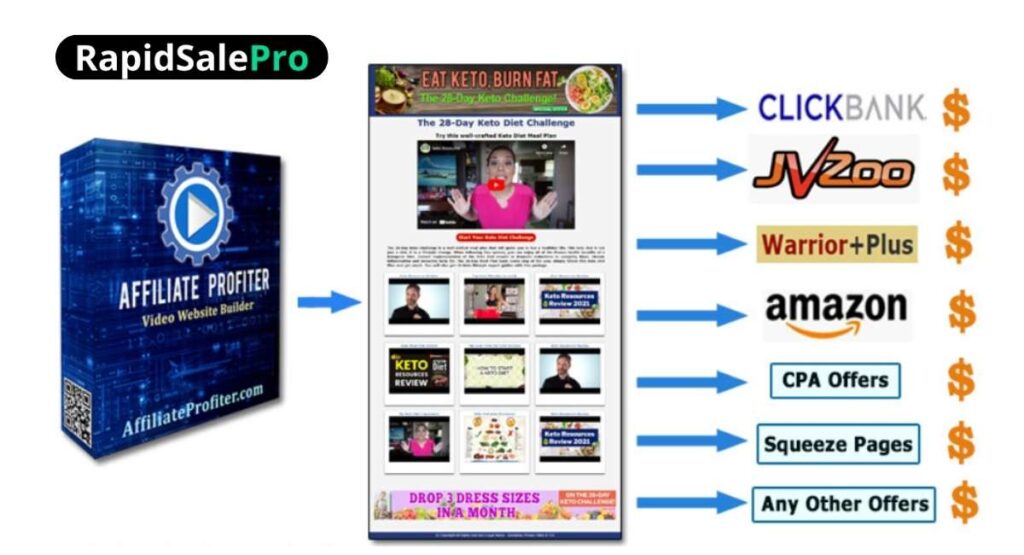Instant Digital Products represent intangible goods or services delivered electronically. They exist solely in digital formats, encompassing software, ebooks, online courses, music, videos, and mobile applications. The internet's rise and technological progress have simplified the creation, distribution, and sales of these products.
Find it out with RapidSalePro right now!
⏩See more at: “E-BUSINESS & E-MARKETING“
Types of Instant Digital Products
- Software: Applications and tools tailored for specific functions, spanning from productivity suites like Microsoft Office to creative software like Adobe Photoshop.
- Ebooks: Digital counterparts of printed books, accessible via devices like e-readers, tablets, or smartphones due to their convenience and accessibility.
- Online Courses: Educational content often featuring video lectures, interactive quizzes, and downloadable materials, covering diverse subjects and offering self-paced learning.
- Music and Streaming Services: Platforms like Spotify and Apple Music granting access to extensive libraries of songs and albums for streaming or download.
- Videos and Movies: Digital entertainment and educational content available for purchase, rental, or streaming via platforms like Netflix and Amazon Prime.
Features of Instant Digital Products

- Instant Delivery: Rapid delivery through email, download links, or online platforms, eliminating inventory management and reducing costs.
- Scalability: Easily reaching large audiences without added production costs, replicating and distributing to multiple customers simultaneously.
- Customization: Tailoring products to individual customer needs, offering personalized learning paths or module selection in online courses.
- Easy Updates: Quick product updates based on feedback or technological advancements, ensuring access to the latest versions.
The Growing Significance of Instant Digital Products
- Global Reach: Potential to reach a worldwide audience without physical distribution, leveraging the internet's connectivity.
- Low Entry Barriers: Minimal upfront investment, enabling individuals and small businesses to enter the market and generate income.
- Changing Consumer Behavior: Shift towards digital consumption for entertainment, education, and convenience, increasing demand across industries.
- Flexibility and Convenience: Providing freedom for creators to work remotely while offering consumers anytime, anywhere access.
Benefits of Selling Instant Digital Products
- Passive Income: Repetitive sales without additional effort, generating revenue continuously.
- Low Production Costs: Reduced expenses compared to physical products, leading to higher profit margins.
- Greater Control: Full control over content, pricing, and distribution, maintaining ownership of intellectual property.
- Unlimited Scalability: Infinite sales potential without concerns about inventory or supply limitations.
Common Misconceptions about Instant Digital Products

- Perceived Value: Digital products offer unique benefits such as instant delivery and customization, adding significant value.
- Piracy Concerns: Measures like digital rights management (DRM) and copyright laws aid in protecting intellectual property.
- Market Size: The vast global market for digital products is facilitated by internet connectivity and technology adoption.
Creating and Selling Instant Digital Products
- Identify Target Audience: Understand audience needs and preferences through market research and feedback.
- Choose Suitable Format: Tailor the product format (ebook, online course, software, etc.) to match content and audience.
- Craft High-Quality Content: Invest in creating engaging content with a unique selling proposition.
- Set Competitive Pricing: Consider product value, market competition, and audience purchasing power when setting prices.
- Select Appropriate Platform: Utilize platforms like Amazon Kindle Direct Publishing, Udemy, or Shopify aligned with goals and audience.
- Implement Marketing Strategies: Leverage social media, content marketing, email marketing, and paid advertising to promote the product.
Marketing Strategies for Instant Digital Products

- Content Marketing: Share valuable content demonstrating expertise and value to attract and engage the target audience.
- Email Marketing: Nurture relationships with potential customers through regular newsletters or exclusive content.
- Social Media Marketing: Increase visibility and engagement through compelling posts, ads, and influencer collaborations.
- Affiliate Marketing: Collaborate with affiliates to reach a wider audience and incentivize sales through referral links.
- Paid Advertising: Utilize platforms like Google Ads or Facebook Ads to drive targeted traffic and increase visibility.
Conclusion
Digital products have revolutionized creation, distribution, and consumption, offering benefits like low production costs, scalability, and instant delivery. The continued growth of digital connectivity ensures their increasing importance. Whether you're a creator or consumer, understanding digital products' types, features, and marketing strategies is pivotal in leveraging the opportunities of the digital era. Embrace the realm of digital products today and explore the vast possibilities it presents!

